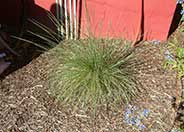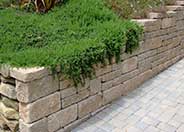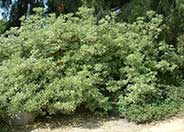
Common name:Brisbane Box
Botanical name:Lophostemon confertus
Brisbane Box (Tristania conferta) is a very fast-growing evergreen tree that is native to Australia. It is a common tree to use in parkways and residential gardens because it is low-water-use, low maintenance, and resistant to pests, disease, and smog conditions. This is a great selection to be used in a medium garden to screen neighboring houses or undesirable views, as the tree is fast-growing and has a dense, upright canopy, maturing at 50’ tall and up to 30’ wide. This tree can take most soil and water conditions, so it can be used in almost all styles of gardens. It is very drought-tolerant, but its larger, dark green leaves make it look lush. When it starts to reach its mature height, the tree can thin out, giving it a more arid look. If the desired effect in the garden is to have a full, dense canopy, it is best to leave the pruning and care to a licensed arborist. There is no need to fertilize this tree as it already has a fast-growth habit, and the supplemental nutrients will only encourage more growth. This tree should be planted at least three feet away from any hardscape areas, eight feet from structures such as houses and buildings, and not near any powerlines. Shrubs and perennials should be planted about two feet away from this tree. It should be irrigated for about 45 minutes once a week when using most in-line drip irrigation systems.

Common name:Pine Muhly, Mexican Deer Grass
Botanical name:Muhlenbergia dubia
This attractive grass reaches 3' tall (with blooms) and wide. Foliage is narrow, green, and evergreen. This plant forms a clump with erect, tan flowers spikes in summer and fall. It prefers full sun in well draining soil. It is drought tolerant once it's established. Heat and cold tolerant.
Maintenance Tips
Muhlenbergia dubia is a wispy native grass with a very symmetrical shape. The arching flowers reach 3’ over an orderly dome shape. This grass requires almost no maintenance if it is planted in its ideal conditions. A sunny location, well-drained soil, and the space to reach its mature size will ensure that it thrives without having to prune for size or shape. It is common to cut perennial grasses back very hard in the winter to prune off the old spent flowers. If you are planning on winter pruning, it is best to wait until you see some new foliage emerge so the newly emerging leaves can cover the cuts quickly.
Common name:Prostrate Rosemary
Botanical name:Rosmarinus officinalis 'Prostratus'
The 'Prostratus' grows to a height of 2'-3' with a spread to 8'. Its flowers are pale, lavender blue in color; the leaves are needle-like with a dark, blue-green color. This plant makes a good ground cover, and its leaves can be used as seasoning in cooking.

Common name:Variegated Tobira
Botanical name:Pittosporum tobira 'Variegata'
This variegated evergreen shrub or small tree has creamy margins on its gray green leaves. In spring, clusters of small, cream-colored flowers appear with the fragrance of orange blossoms. Variegated Tobira is often used to brighten shaded areas.
Designer: N/A
Photographer: GardenSoft
Maintain a two to four inch layer of mulch on the soil surface to reduce weeds, infiltrate rain water, and reduce compaction.
Remove irrigation water and fertilizer from areas where you don't want weeds to grow.